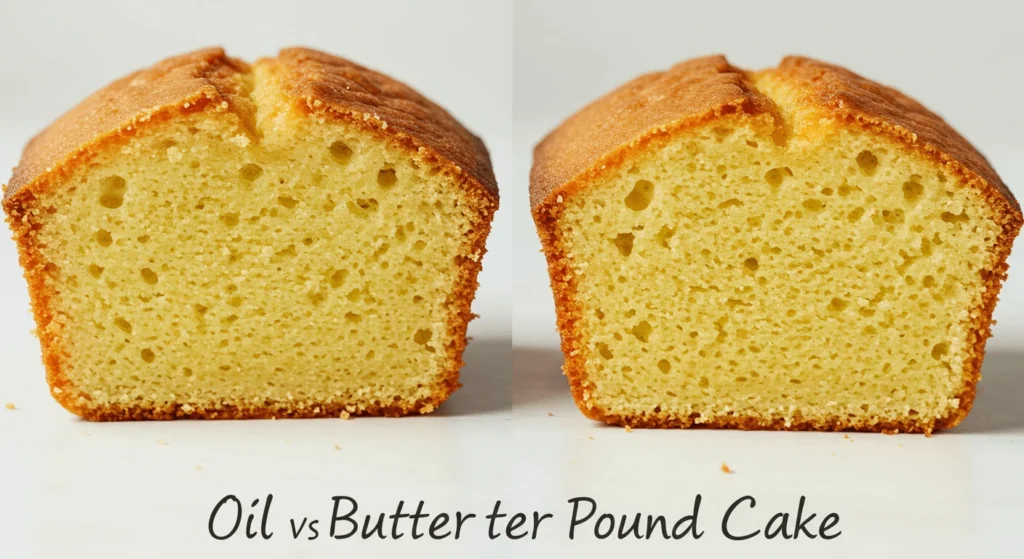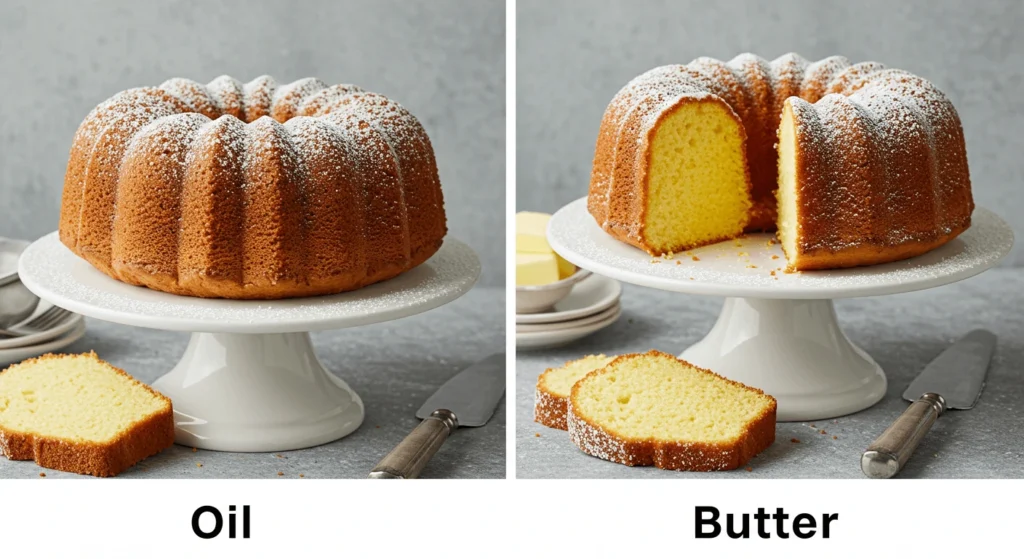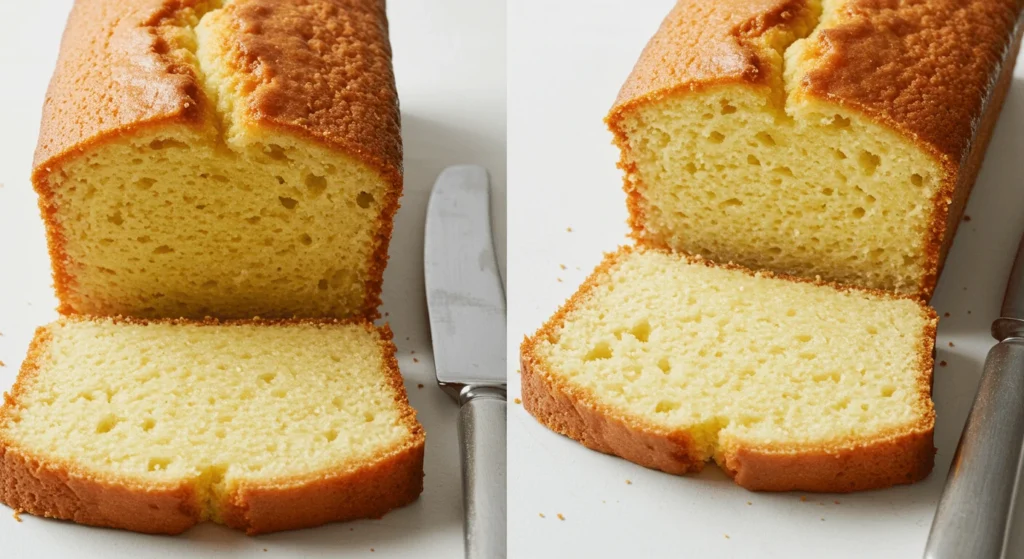Oil vs. Butter in Pound Cake has been a long-standing debate among bakers and dessert enthusiasts alike. Both fats play pivotal roles in creating the beloved pound cake, but their unique characteristics can lead to significantly different outcomes. Understanding how each ingredient impacts flavor, texture, and overall quality can help you decide which fat to use for your next baking adventure.
Butter vs. Oil: The Great Pound Cake Debate
When it comes to baking, fat is more than just an ingredient; it’s a cornerstone that determines the final product’s taste and texture. In the world of pound cake, two primary contenders emerge: butter and oil. Each brings its own set of qualities that influences not just the structure of the cake but also its flavor profile and moistness. The choice between oil and butter can often feel daunting, yet understanding the science behind these ingredients can clear up some confusion and guide bakers toward making the best decision for their recipes.
The great debate over Oil vs. Butter in Pound Cake extends beyond personal preference, making its way into the realms of culinary expertise, health considerations, and even cultural traditions. In this section, we will delve deep into the essential roles that both butter and oil play in baking, and explore how these common fats can produce drastically different results in our beloved pound cakes.
Understanding the Differences: Fat in Baking
Fat serves multiple purposes in baking, from providing moisture to creating a tender crumb. Learning how each type of fat works can enhance your baking skills dramatically.
The Role of Butter: Flavor, Texture, and Structure
Butter is revered for its rich flavor and ability to enhance the overall taste of baked goods. Its unique composition contains water, milk solids, and fat, which contributes to a beautiful emulsification when creamed with sugar. This emulsion leads to a stable structure that gives pound cakes their characteristic density.
The flavors that butter imparts are often described as creamy and luxurious. As it melts during baking, the water content transforms into steam, helping to leaven the cake and create a light structure. Additionally, butter contributes to browning due to the Maillard reaction, resulting in a beautifully golden crust that appeals to the senses.
However, while butter has its merits, it can sometimes lead to a denser cake if not incorporated correctly. This is where the technique of creaming can make all the difference. Careful attention to the mixing process ensures that air is trapped within the batter, leading to a lighter result.

The Role of Oil: Moisture, Tenderness, and Simplicity
Contrastingly, oil is known for its straightforward application and consistent results. Unlike butter, which requires careful melting and creaming, oil can be mixed directly into the dry ingredients. This simplicity is appealing for those who may be intimidated by intricate baking techniques.
The main advantage of using oil in pound cake is the extra moisture it provides. Cakes made with oil tend to remain fresher and moister for a longer period, thanks to oil’s liquid consistency. Moreover, because it doesn’t contain any water or milk solids like butter, oil helps maintain a uniform texture throughout the cake, leading to an incredibly soft and tender crumb.
From a flavor standpoint, oil is neutral, allowing other ingredients such as vanilla, citrus zest, or chocolate to shine through without interference. However, this lack of depth means that cakes made with oil might benefit from additional flavoring agents to achieve a more complex profile.
Comparing Fat Content and Saturation
One of the most critical differences between butter and oil is their fat content and saturation levels. Butter is approximately 80% fat, with the remaining being water and milk solids. As a saturated fat, butter solidifies at room temperature, which can lead to a firmer cake with a more structured crumb.
In contrast, oil is entirely fat, devoid of any water content. It often consists of unsaturated fats, which are more fluid at room temperature. This can result in a softer, more moist pound cake. Understanding these differences can guide bakers in deciding which ingredient to use based on the desired outcome for their cakes.
The Impact of Each Fat on Browning and Rise
The browning and rising of a cake are influenced by the type of fat used. Butter, with its higher water content, generates steam when heated, contributing to the cake’s rise. This steam creates small air pockets, leading to a lighter texture. On the other hand, oil, being liquid at the outset, does not contribute to the same degree of leavening.
When it comes to browning, butter excels due to the presence of milk solids, which undergo the Maillard reaction during baking. This reaction not only enhances flavor but also creates that irresistible golden-brown crust that many bakers aim for. Conversely, cakes made with oil may not develop the same level of color or flavor complexity in their crusts, yielding a paler appearance.
Pound Cake Recipes: Butter vs. Oil

Now that we have explored the fundamental differences between butter and oil, it’s time to put theory into practice. In this section, we will present two delicious pound cake recipes—one using butter and the other using oil—to showcase the distinct traits of each fat. We will also analyze them side-by-side to help you understand how these variations affect the final product.
Classic Butter Pound Cake Recipe: Ingredients and Method
A classic butter pound cake is a timeless recipe that has stood the test of time. Here’s what you’ll need for this traditional treat:
- 1 cup unsalted butter, softened
- 2 cups granulated sugar
- 4 large eggs, at room temperature
- 2 teaspoons pure vanilla extract
- 3 cups all-purpose flour
- 1 teaspoon baking powder
- ½ teaspoon salt
- 1 cup whole milk, at room temperature
To prepare this delicious butter pound cake, begin by preheating your oven to 325°F (163°C). Grease and flour a bundt pan or loaf pan to ensure easy removal of the cake once baked.
Next, cream the softened butter and granulated sugar together in a large mixing bowl until light and fluffy—this can take around five minutes. Gradually add the eggs, one at a time, mixing well after each addition. Incorporate the vanilla extract into the mixture, enhancing the cake’s flavor.
In a separate bowl, sift together the flour, baking powder, and salt. Gradually add this dry mixture to the wet ingredients, alternating with the milk, and mix until just combined—be cautious not to overmix, as this can lead to a dense cake.
Pour the batter into the prepared pan and bake for approximately 60-75 minutes, or until a toothpick inserted into the center comes out clean. Once cooled, you can dust the cake with powdered sugar for a delightful finish.
Oil-Based Pound Cake Recipe: Ingredients and Method
For an equally enticing oil-based pound cake, the following ingredients will yield a delightful result:
- 1 cup vegetable oil
- 2 cups granulated sugar
- 4 large eggs, at room temperature
- 2 teaspoons pure vanilla extract
- 3 cups all-purpose flour
- 1 teaspoon baking soda
- ½ teaspoon salt
- 1 cup buttermilk, at room temperature
Start by preheating your oven to 325°F (163°C), just like with the butter cake. Grease and flour your chosen pan.
In a large mixing bowl, combine the vegetable oil and sugar, whisking them together until blended. Add in the eggs one at a time, mixing until each is fully incorporated before adding the next. Stir in the vanilla extract to round out the batter’s flavor.
In another bowl, whisk together the flour, baking soda, and salt. Gradually incorporate this dry mixture into the egg-oil-sugar blend, alternating with the buttermilk. As with the butter cake, take care not to overmix.
Transfer the batter to the prepared pan and bake for about 60-70 minutes, or until a toothpick inserted into the center comes out clean. Allow the cake to cool before serving.
Side-by-Side Comparison: Recipe Analysis
At this point, it’s essential to compare both recipes side by side to understand the nuances of each method.
In terms of preparation, the butter cake requires a creaming step, which develops air into the batter, resulting in a fluffier cake. Meanwhile, the oil-based cake benefits from a more straightforward mixing process, streamlining the overall experience for novice bakers.
In terms of flavor and texture, the butter cake is likely to present a richer taste characterized by the creaminess of the butter. Conversely, the oil cake tends to be lighter, with a softer crumb that offers a different kind of satisfaction.
Baking times for both cakes are similar, but the visual appeal will differ. The butter cake typically emerges with a beautiful golden-brown crust, while the oil cake remains lighter in color and may appear slightly less impressive visually.
Ingredient Substitutions and Adjustments
For those who might want to experiment with their recipes or accommodate dietary preferences, knowing how to substitute certain ingredients can be invaluable. When substituting oil for butter, the general rule is to use about three-quarters the amount of oil compared to butter. This is due to the higher fat content in butter.
If you prefer a healthier option, consider using applesauce or Greek yogurt as a replacement for oil in your cake recipes. These substitutions can lower calorie counts while keeping the cake moist.
For those seeking dairy-free options, vegetable shortening or even coconut oil can stand in for butter or regular oil, offering alternative flavors and textures.
Taste Test and Texture Analysis: The Results
After whipping up our butter and oil pound cakes, it’s time to dive into the tasting process. A taste test can reveal much about the qualities of each cake, painting a clearer picture of how the choice between oil and butter influences the final product.

Flavor Profile Comparison: Butter vs. Oil
Butter-infused pound cake typically presents a robust and full-bodied flavor. The richness of the butter elevates the taste experience, creating a comforting sensation that resonates with traditional baking practices. Each bite bursts with a creamy essence that harmonizes beautifully with added flavors like vanilla or lemon.
On the other hand, cakes made with oil deliver a milder flavor profile. They are adaptable canvases that absorb other flavors effectively. While they might not boast the same depth as their butter counterparts, they can still shine when paired with bold flavorings such as spices or zests, allowing for endless creativity.
Texture Analysis: Crumb Structure, Moisture, and Mouthfeel
When it comes to texture, the differences become glaringly obvious. Butter pound cakes tend to have a denser crumb structure due to the creaming process, lending itself to a more robust mouthfeel. This density can be comforting, perfect for pairing with a cup of tea or coffee.
Conversely, oil-based cakes offer a lighter, airy crumb that is exceptionally moist. The oil maintains freshness longer, allowing for a delightful eating experience that stays tender even days after baking. For those who prioritize moistness, the oil cake reigns supreme.
Visual Appeal: Color, Appearance, and Overall Impression
Visual presentation plays an important role in how we perceive food. A butter pound cake typically showcases a rich golden hue, indicative of successful browning. The crust’s slight crunch contrasts beautifully with the soft interior, creating an inviting sight.
Oil pound cakes, however, may appear paler and flatter in comparison. While they still look appetizing, they lack the allure of the golden crust that characterizes a traditional butter cake. Nevertheless, with creative toppings or glazes, an oil cake can still impress on the aesthetic front.
Exploring the Preferences: Which is Better?
With our comparisons complete, it’s time to reflect on which fat is truly “better” for pound cake. The answer, however, is subjective and depends largely on personal preference, baking style, and dietary needs.
Factors Influencing Preference: Taste, Texture, and Dietary Needs
For many, the choice between oil and butter boils down to taste. Some people simply adore the rich, creamy flavor of butter, finding it irreplaceable in baking. Others may gravitate toward the versatility of oil, appreciating the moistness and adaptability it offers.
Texture preferences can also sway opinions. If you prefer a dense and hearty slice of cake, butter may be your go-to. Alternatively, if you enjoy a light, tender cake that melts in your mouth, oil presents an excellent option.
Dietary considerations can further complicate things. Those with lactose intolerance or a desire for vegan options may lean toward oil as a suitable alternative, while others committed to traditional baking methods may insist on butter for its authentic flavor.
Choosing the Right Fat for Your Baking Style
Ultimately, choosing between oil and butter comes down to individual baking style. Bakers who thrive on experimenting might prefer oil due to its ease of use and reliability. Meanwhile, purists may find joy in mastering the art of working with butter, reveling in the deeper complexities it brings to their creations.
Your choice may also depend on the occasion. For gatherings that call for a show-stopping dessert, a butter pound cake may elevate the experience. On the other hand, casual family dinners might warrant the simplicity of an oil-based cake that everyone can enjoy.
Recipes for Different Results: Dense vs. Light, Rich vs. Simple
When baking, remember that there is no one-size-fits-all solution. You can create recipes tailored to your preferred results by adjusting the fats you use. If you desire a denser cake with a rich flavor, stick with butter and embrace traditional methods. If you’re leaning towards a lighter, more moist experience, opt for oil.
You can even blend the two for the best of both worlds! Using half oil and half butter provides a pleasing balance of flavors and textures, showcasing the best features of each ingredient.
Conclusion
In the end, the battle of Oil vs. Butter in Pound Cake underscores the beauty and diversity of baking. Both fats offer unique advantages and challenges, influencing flavor, texture, and presentation in various ways. Whether you favor the richness of butter or the moisture of oil, each choice comes with its own set of rewards and delights.
By understanding the science behind these ingredients, you can make informed decisions that align with your baking goals and personal tastes. After all, the joy of baking lies not only in the finished product but also in the exploration and experimentation that lead to that delectable slice of cake. So, whether you choose oil, butter, or a combination of both, embrace the process and indulge in the delicious results. Happy baking!
For more recipes please click on below links:
Moist Muffins – Mastering the Art of Baking These Delightful Treats


1 thought on “Oil vs. Butter in Pound Cake – Uncovering to the Perfect Dessert”